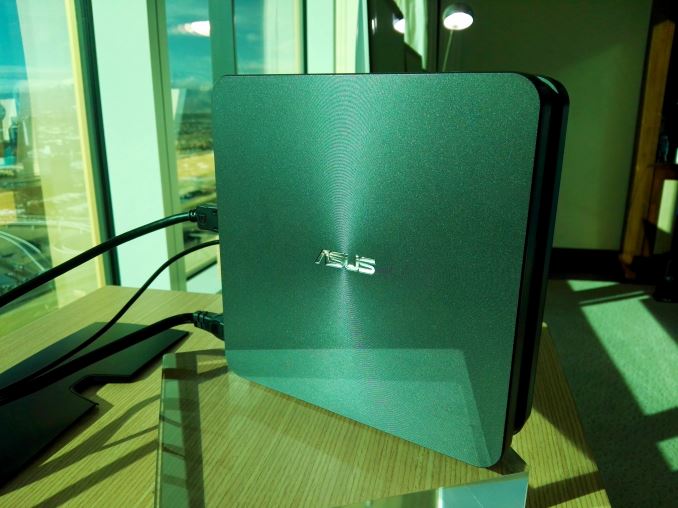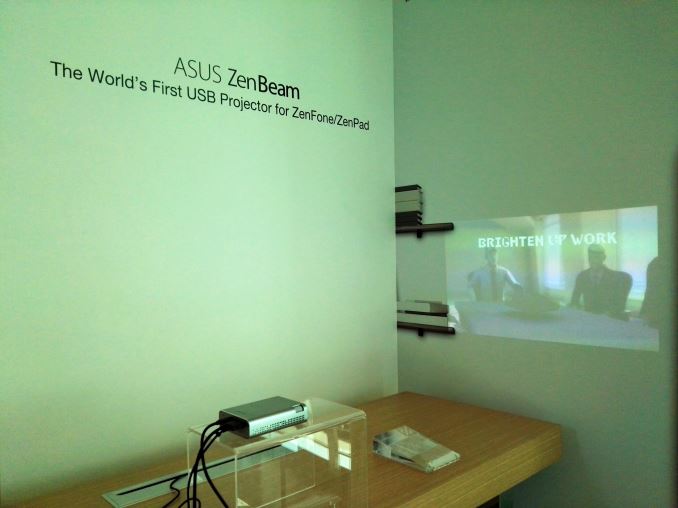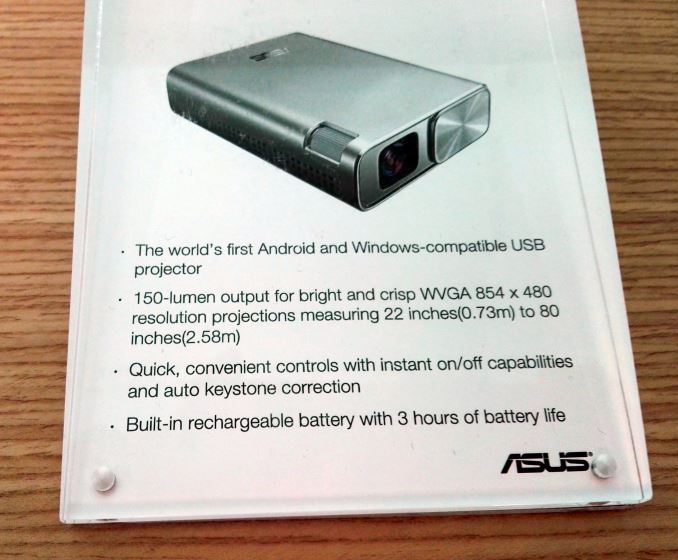ASUS Booth Tour at CES 2016: 10G Switches, External GPU Dock, USB-C Monitor and more
by Ian Cutress on January 19, 2016 9:00 AM ESTSticks Galore
For mini PCs, ASUS had the Chromebit and VivoStick models on display, shown in a couple of colors. The Chromebit is unsurprisingly Chrome OS, and the VivoStick using Windows 10, competing against hardware such as the Intel Compute Stick (read our recent review of the Cherry Trail version here).
The Chromebit is powered by a Rockchip quad-core RK3288C and has 16 GB of eMMC and 2 GB of memory. The Vivostick is based on Intel’s Cherry Trail Atom processor, and also has 2 GB of memory, but 32 GB of eMMC storage. There are 2 USB 2.0 ports available on the VivoStick.
The VivoMini VC65 line of mini-PCs, focused on a mix of vertical business markets, was shown. These feature desktop class processors and support for up to four storage devices, meaning they could be turned into a very compact NAS. The VC65R model supports RAID as well. These were announced quite a while ago, but it was good to see them in what looks like a slightly bigger form factor than Intel’s new 5x5 ‘STX’ platform.
Next to the mini-PCs was this mini-projector unit, called ZenBeam. The 150 lumen output and 854x480 projection doesn’t sound like much, but the 6000 mAh battery in the unit is designed to last at least the length of a couple of impromptu presentations when it isn’t on charge.














50 Comments
View All Comments
DanNeely - Tuesday, January 19, 2016 - link
Is the back of that phone actually made up of a bunch of triangular panels at angles to each other; or does the finish just fake the look?WorldWithoutMadness - Tuesday, January 19, 2016 - link
It is 3D (source http://www.androidcentral.com/hands-asus-zenfone-2...Panzerknacker - Tuesday, January 19, 2016 - link
I just dont understand why did 10G never become mainstream and is it so damn expensive? Back when 100mbit was mainstream the price of 1G was higher but nowhere near $760 for a switch. 1g is now mainstream for a decade or so, what takes it so long? Did we reach the limit of copper networking? I mean, in datacenters there has to be a enormous market for fast networking, I cannot understand why prices are still so high because on a huge market you would expect a lot a competition and fast development of hardware. Or did they completely move to different networking standards in datacenters, like fibre?Reflex - Tuesday, January 19, 2016 - link
Power consumption is very high compared to gigabit, and wireless replaced ethernet for most home and small office use, thus negating economies of scale which normally would drive prices down.Lieuchikaka - Thursday, June 2, 2016 - link
http://mavangvn.vn/ma-vang-dien-thoai/dien-thoai-s...TwistedKestrel - Tuesday, January 19, 2016 - link
It's mostly the ubiquity of 1GbE vs the handful of vendors making 10GbE parts. 1GbE PHYs are cheap as dirt, and 10GbE is two orders of magnitude more expensive... and there aren't that many people that want it yet. Once 1Gb+ throughput on 802.11ac radios becomes more commonplace instead of mostly theoretical, that would be something of a driver for consumer 10GbE.Interesting that a few US ISPs have upcoming or available service in excess of 1Gb, I wonder what kind of connections their equipment would have
DanNeely - Tuesday, January 19, 2016 - link
For consumer service, I'd be really surprised if it was anything but a combined modem/pretend it actually is able to achieve multi-gigabit speeds wifi router.iwod - Tuesday, January 19, 2016 - link
They have new standard NBase-T which provides 2.5Gbps and 5Gbps on Normal CAT 6 Cable. But no idea why no company are getting products out.Alex_M - Wednesday, January 20, 2016 - link
The real benefits for NBase-T will be 2.5/5 Gbps over exisitng Cat5e (not Cat6) upto 100m. It means we don't have to replace all those existing cable runs to benefit from the higher speed. Its fairly new but I hear that the silicon has started sampling....Lieuchikaka - Thursday, June 2, 2016 - link
http://mavangvn.vn/ma-vang-dien-thoai/dien-thoai-s...